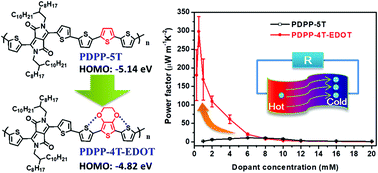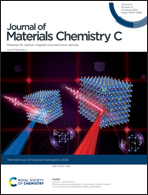Enhancement of the thermoelectric performance of DPP based polymers by introducing one 3,4-ethylenedioxythiophene electron-rich building block†
Abstract
Donor–acceptor (D–A) type conjugated polymers are promising high performance thermoelectric (TE) materials due to their high carrier mobility, versatile structure and easily tuneable doping level. In this work, we have demonstrated a significant enhancement in the TE performance of diketopyrrolopyrrole (DPP) based D–A conjugated polymers by the incorporation of one 3,4-ethylenedioxythiophene (EDOT) building block. When one thiophene building block of PDPP-5T was substituted by EDOT, the HOMO level of PDPP-4T-EDOT could be increased and the coplanarity of the conjugated backbone was slightly enhanced, which could facilitate the efficient p-doping of the conjugated polymer. Compared with PDPP-5T, PDPP-4T-EDOT exhibited a much higher optimal TE power factor of 298.2 μW m−1 K−2 at a lower doping level, which is among the highest value for p-type organic thermoelectric materials based on D–A conjugated polymers. The results provide attractive guidance for the design and development of high performance thermoelectric conjugated polymers.

- This article is part of the themed collection: Journal of Materials Chemistry C Emerging Investigators


 Please wait while we load your content...
Please wait while we load your content...